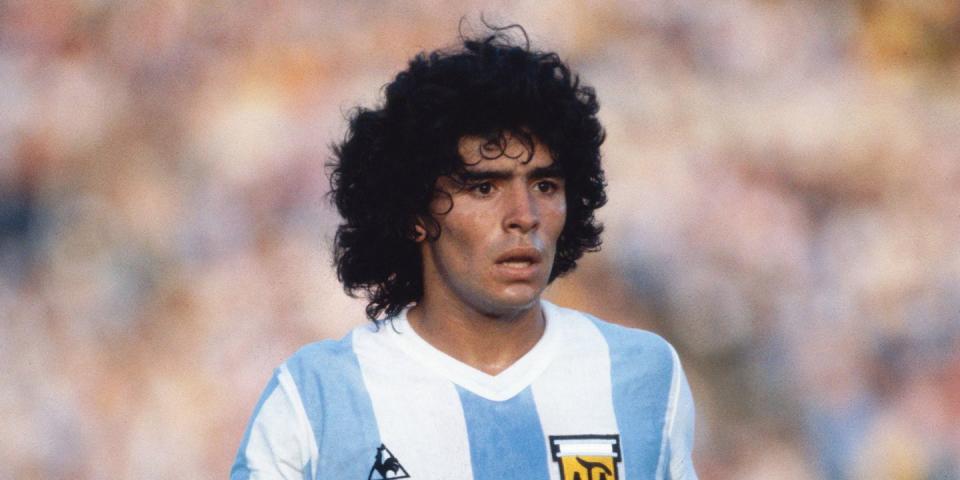Diego Maradona, A World Cup Legend

On 25 November 2020, legendary Argentinian football Diego Maradona sadly passed away at the age of 60. Considered to be one of the greatest footballers of all-time, he led his country to a World Cup victory in 1986 and became a cult figure at Boca Juniors, Barcelona and Napoli, as well as a host of other clubs.
He retired in 1997, but remains a hero to new generations of young footballers. In this article from the August 2014 issue of Esquire, 'Hand of God: A Biography of Diego Maradona' author Jimmy Burns profiles Argentina's diminutive genius.
Whatever doubts endure about the character of Diego Maradona, the goal he scored against Bobby Robson’s England in the 1986 World Cup stands as one of, if not the, best in the history of the game.
I am talking here not of his first goal in that quarter-final, a clear piece of mischief helped by abysmally poor refereeing, but that second winning goal of sublime craft and execution.
It began with Maradona picking up the ball inside his own half and keeping it so close to his boots that it seemed glued to them. He then proceeded to carve his way through the English side before finally beating Shilton with the effortless movement of a slalom skier. As Maradona’s teammate Jorge Valdano put it later, “It was Diego’s personal adventure, one that was totally spectacular.”
Both goals against England epitomised man and legend. The first showed Maradona the urchin born of Buenos Aires not only cheating but getting away with it — an Argentine artful dodger. The second showed Maradona the naturally gifted player, whose low sense of gravity, acceleration, control and accuracy translated into unrivalled greatness on the field.
His performance in leading Argentina to ultimate conquest in the World Cup in Mexico earned him the Golden Ball award as the best player title of the tournament. Standing at 5ft 5in, and yet, at his peak, with the strength of will and balance in body to withstand an extraordinary catalogue of physical abuse, some of it self-inflicted, Maradona combined the skill and vision of a Pelé — with whom he shares the title of Fifa’s Player of the Century — with the versatility of Johan Cruyff, the inspiration behind the best of Dutch and Spanish football.
Maradona’s helter-skelter life provides a fascinating story of a failed genius who constantly courted controversy in his rise to fame. The legend begins with the boy Maradona showing off his remarkable ball control in the dusty playing field of the shanty town where he was born.
In his formative years, Maradona played memorable matches for FC Barcelona and Napoli, gaining a reputation as the best player of the Spanish and Italian leagues. But he later hit headlines because of his developing cocaine addiction, culminating with his dramatic expulsion from the 1994 World Cup after a positive drugs test.
Despite some short-lived comebacks as a player in his native Argentina and an unsuccessful spell as manager of the Argentine squad in the 2010 World Cup in South Africa, Maradona never regained the pinnacle he reached in Mexico.
Amid continuing off-field controversies, Maradona, an overweight 53-year-old, has spent the last year as “spiritual coach” and part-time player in a fifth division Argentine club, Deportivo Riestra. He has struggled to perpetuate the myth of his own godlike status, without assuming responsibility for his failings and the way he has squandered his talent. It remains his ultimate flaw.
You Might Also Like

 Yahoo Sport
Yahoo Sport 





































